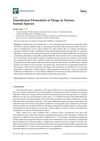TLDR More research is needed to effectively measure how well GHK–Cu in liposomes penetrates the skin.
The review explores the potential of using liposomes to enhance the skin permeation of the antiaging compound GHK–Cu, which naturally struggles to penetrate the skin's barrier. Liposomes, due to their biocompatibility, could improve the delivery and efficacy of GHK–Cu. However, there is a significant research gap in studying the permeation of liposome-encapsulated GHK–Cu, as most studies focus on its free form. The review emphasizes the need for methodological advancements to better assess the effectiveness of liposomal carriers. Various methods for measuring skin permeation are discussed, with the Strat-M® synthetic membrane noted for its reliability. Encapsulation in ionic liquids has shown promise in enhancing skin penetration. Despite advancements, understanding the skin permeation of GHK–Cu-liposome systems remains a research gap, and improved methodologies are needed to study these interactions with human skin.
 2 citations
,
November 2023 in “Bioactive materials”
2 citations
,
November 2023 in “Bioactive materials” New method improves copper peptide delivery for hair growth three times better than current options.
20 citations
,
January 2022 in “REVIEWS ON ADVANCED MATERIALS SCIENCE” Nanoparticles can make cosmetics more effective but have challenges like cost and safety.
 10 citations
,
May 2021 in “Expert Opinion on Drug Delivery”
10 citations
,
May 2021 in “Expert Opinion on Drug Delivery” Coenzyme Q10 vesicular formulations can potentially treat androgenic alopecia by promoting hair growth and thickness.
 149 citations
,
September 2017 in “Pharmaceutics”
149 citations
,
September 2017 in “Pharmaceutics” Pig skin is a good substitute for human skin to measure drug absorption, but differences in skin structure and enzymes across species must be considered.
 277 citations
,
July 2011 in “Journal of the Dermatology Nurses’ Association”
277 citations
,
July 2011 in “Journal of the Dermatology Nurses’ Association” The skin's layers protect, sense, and regulate the body's internal balance, but can be prone to cancer.

New treatments for hair loss should target eight main causes and use specific plant compounds and peptides for better results.
 February 2024 in “Skin health and disease”
February 2024 in “Skin health and disease” Many popular skincare products claim to prevent aging but lack strong evidence to prove their effectiveness and safety.
1 citations
,
December 2022 in “Bioactive Materials” The microneedle patch with quercetin, zinc, and copper effectively promotes hair regrowth for androgenic alopecia.
7 citations
,
August 2020 in “Plastic and reconstructive surgery. Global open” QR 678 and QR 678 Neo are safe and promote hair growth, potentially helping chemotherapy-induced hair loss.
Combining PRP with a special lotion is more effective for hair loss than PRP alone.





